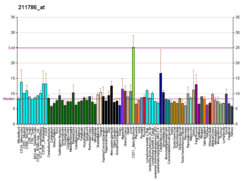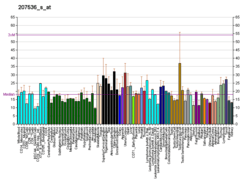CD137
CD137 is a member of the tumor necrosis factor (TNF) receptor family. Its alternative names are tumor necrosis factor receptor superfamily member 9 (TNFRSF9), 4-1BB and induced by lymphocyte activation (ILA). It is of interest to immunologists as a co-stimulatory immune checkpoint molecule.
Expression
CD137 can be expressed by activated T cells, but to a larger extent on CD8 than on CD4 T cells. In addition, CD137 expression is found on dendritic cells, B cells, follicular dendritic cells, natural killer cells, granulocytes and cells of blood vessel walls at sites of inflammation.
Specific effects on cells
The best characterized activity of CD137 is its costimulatory activity for activated T cells. Crosslinking of CD137 enhances T cell proliferation, IL-2 secretion, survival and cytolytic activity. Further, it can enhance immune activity to eliminate tumors in mice.
As a drug target
Utomilumab
Utomilumab (PF-05082566) targets this receptor to stimulate a more intense immune system attack on cancers.[7] It is a fully human IgG2 monoclonal antibody.[8] It is in early clinical trials.[7] As of June 2016 5 clinical trials are active.[9]
See also
- 4-1BB ligand
- Urelumab
References
- GRCh38: Ensembl release 89: ENSG00000049249 - Ensembl, May 2017
- GRCm38: Ensembl release 89: ENSMUSG00000028965 - Ensembl, May 2017
- "Human PubMed Reference:". National Center for Biotechnology Information, U.S. National Library of Medicine.
- "Mouse PubMed Reference:". National Center for Biotechnology Information, U.S. National Library of Medicine.
- Jang IK, Lee ZH, Kim YJ, Kim SH, Kwon BS (Jan 1998). "Human 4-1BB (CD137) signals are mediated by TRAF2 and activate nuclear factor-kappa B". Biochem. Biophys. Res. Commun. 242 (3): 613–20. doi:10.1006/bbrc.1997.8016. PMID 9464265.
- Arch RH, Thompson CB (Jan 1998). "4-1BB and Ox40 are members of a tumor necrosis factor (TNF)-nerve growth factor receptor subfamily that bind TNF receptor-associated factors and activate nuclear factor kappaB". Mol. Cell. Biol. 18 (1): 558–65. doi:10.1128/MCB.18.1.558. PMC 121523. PMID 9418902.
- Pfizer cancer drug shows promise in combo with Merck's Keytruda. May 2016
- Phase 1 Study of Utomilumab (PF-05082566) In Combination with Rituximab in Patients with CD20+ NHL (Study B1641001)
- PF-05082566 trials
External links
Further reading
- Kwon BS, Weissman SM (1989). "cDNA sequences of two inducible T-cell genes". Proc. Natl. Acad. Sci. U.S.A. 86 (6): 1963–7. doi:10.1073/pnas.86.6.1963. PMC 286825. PMID 2784565.
- Schwarz H, Tuckwell J, Lotz M (1993). "A receptor induced by lymphocyte activation (ILA): a new member of the human nerve-growth-factor/tumor-necrosis-factor receptor family". Gene. 134 (2): 295–8. doi:10.1016/0378-1119(93)90110-O. PMID 8262389.
- Sica G, Chen L (2000). "Biochemical and immunological characteristics of 4-1BB (CD137) receptor and ligand and potential applications in cancer therapy". Arch. Immunol. Ther. Exp. (Warsz.). 47 (5): 275–9. PMID 10604232.
- Schwarz H (2005). "Biological activities of reverse signal transduction through CD137 ligand". J. Leukoc. Biol. 77 (3): 281–6. doi:10.1189/jlb.0904558. PMID 15618293.
- Kwon BS, Weissman SM (1989). "cDNA sequences of two inducible T-cell genes". Proc. Natl. Acad. Sci. U.S.A. 86 (6): 1963–7. doi:10.1073/pnas.86.6.1963. PMC 286825. PMID 2784565.
- Zhou Z, Kim S, Hurtado J, Lee ZH, Kim KK, Pollok KE, Kwon BS (1995). "Characterization of human homologue of 4-1BB and its ligand". Immunol. Lett. 45 (1–2): 67–73. doi:10.1016/0165-2478(94)00227-I. PMID 7622190.
- Alderson MR, Smith CA, Tough TW, Davis-Smith T, Armitage RJ, Falk B, Roux E, Baker E, Sutherland GR, Din WS (1994). "Molecular and biological characterization of human 4-1BB and its ligand". Eur. J. Immunol. 24 (9): 2219–27. doi:10.1002/eji.1830240943. PMID 8088337.
- Schwarz H, Tuckwell J, Lotz M (1994). "A receptor induced by lymphocyte activation (ILA): a new member of the human nerve-growth-factor/tumor-necrosis-factor receptor family". Gene. 134 (2): 295–8. doi:10.1016/0378-1119(93)90110-O. PMID 8262389.
- Schwarz H, Blanco FJ, von Kempis J, Valbracht J, Lotz M (1996). "ILA, a member of the human nerve growth factor/tumor necrosis factor receptor family, regulates T-lymphocyte proliferation and survival". Blood. 87 (7): 2839–45. PMID 8639902.
- Loo DT, Chalupny NJ, Bajorath J, Shuford WW, Mittler RS, Aruffo A (1997). "Analysis of 4-1BBL and laminin binding to murine 4-1BB, a member of the tumor necrosis factor receptor superfamily, and comparison with human 4-1BB". J. Biol. Chem. 272 (10): 6448–56. doi:10.1074/jbc.272.10.6448. PMID 9045669.
- Schwarz H, Arden K, Lotz M (1997). "CD137, a member of the tumor necrosis factor receptor family, is located on chromosome 1p36, in a cluster of related genes, and colocalizes with several malignancies". Biochem. Biophys. Res. Commun. 235 (3): 699–703. doi:10.1006/bbrc.1997.6870. PMID 9207223.
- Arch RH, Thompson CB (1998). "4-1BB and Ox40 are members of a tumor necrosis factor (TNF)-nerve growth factor receptor subfamily that bind TNF receptor-associated factors and activate nuclear factor kappaB". Mol. Cell. Biol. 18 (1): 558–65. doi:10.1128/MCB.18.1.558. PMC 121523. PMID 9418902.
- Jang IK, Lee ZH, Kim YJ, Kim SH, Kwon BS (1998). "Human 4-1BB (CD137) signals are mediated by TRAF2 and activate nuclear factor-kappa B". Biochem. Biophys. Res. Commun. 242 (3): 613–20. doi:10.1006/bbrc.1997.8016. PMID 9464265.
- Kim YJ, Kim SH, Mantel P, Kwon BS (1998). "Human 4-1BB regulates CD28 co-stimulation to promote Th1 cell responses". Eur. J. Immunol. 28 (3): 881–90. doi:10.1002/(SICI)1521-4141(199803)28:03<881::AID-IMMU881>3.0.CO;2-0. PMID 9541583.
- Saoulli K, Lee SY, Cannons JL, Yeh WC, Santana A, Goldstein MD, Bangia N, DeBenedette MA, Mak TW, Choi Y, Watts TH (1998). "CD28-independent, TRAF2-dependent costimulation of resting T cells by 4-1BB ligand". J. Exp. Med. 187 (11): 1849–62. doi:10.1084/jem.187.11.1849. PMC 2212301. PMID 9607925.
- Langstein J, Michel J, Schwarz H (1999). "CD137 induces proliferation and endomitosis in monocytes". Blood. 94 (9): 3161–8. PMID 10556203.
- Jang LK, Lee ZH, Kim HH, Hill JM, Kim JD, Kwon BS (2002). "A novel leucine-rich repeat protein (LRR-1): potential involvement in 4-1BB-mediated signal transduction". Mol. Cells. 12 (3): 304–12. PMID 11804328.
- Cooper D, Bansal-Pakala P, Croft M (2002). "4-1BB (CD137) controls the clonal expansion and survival of CD8 T cells in vivo but does not contribute to the development of cytotoxicity". Eur. J. Immunol. 32 (2): 521–9. doi:10.1002/1521-4141(200202)32:2<521::AID-IMMU521>3.0.CO;2-X. PMID 11828369.
- Wilcox RA, Chapoval AI, Gorski KS, Otsuji M, Shin T, Flies DB, Tamada K, Mittler RS, Tsuchiya H, Pardoll DM, Chen L (2002). "Cutting edge: Expression of functional CD137 receptor by dendritic cells". J. Immunol. 168 (9): 4262–7. doi:10.4049/jimmunol.168.9.4262. PMID 11970964.
- Shulzhenko N, Morgun A, Chinellato AP, Rampim GF, Diniz RV, Almeida DR, Gerbase-DeLima M (2002). "CD27 but not CD70 and 4-1BB intragraft gene expression is a risk factor for acute cardiac allograft rejection in humans". Transplant. Proc. 34 (2): 474–5. doi:10.1016/S0041-1345(02)02600-3. PMID 12009595.
- Pauly S, Broll K, Wittmann M, Giegerich G, Schwarz H (2002). "CD137 is expressed by follicular dendritic cells and costimulates B lymphocyte activation in germinal centers". J. Leukoc. Biol. 72 (1): 35–42. PMID 12101260.





